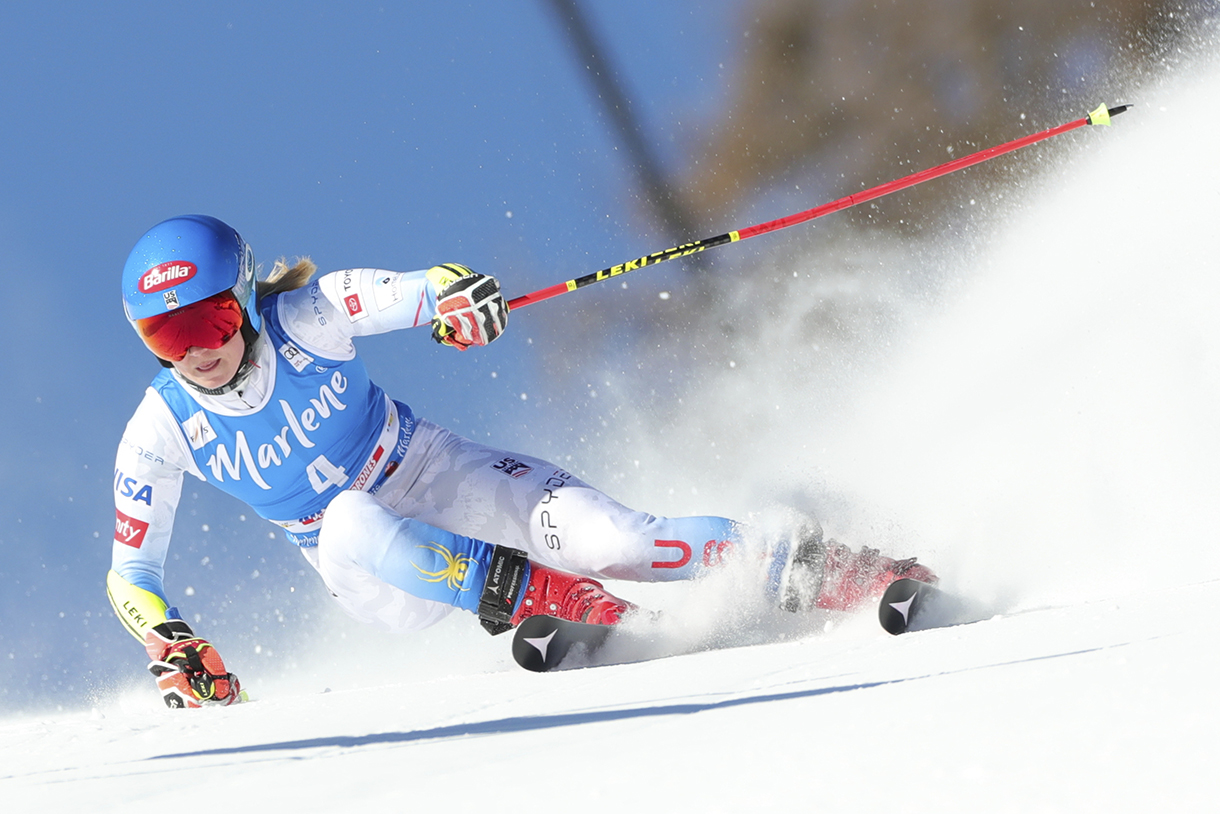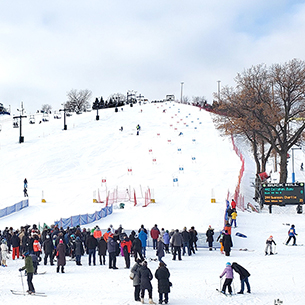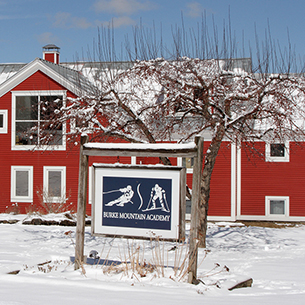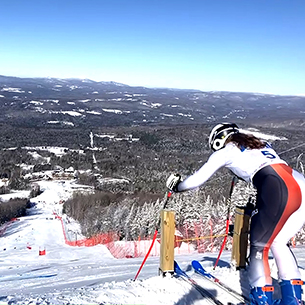
Olympic Beginnings
As the United States’ best alpine skiers race for gold in Beijing, many of their Olympic dreams were born on small hills and at ski academies set in unexpected locales worth a visit.




Led by two-time Olympic gold medalist and six-time World Champion Mikaela Shiffrin, the U.S. Ski Team headed to Beijing with gold-tinted dreams and plenty of medal-driven motivation. More than a dozen American athletes are taking to the slopes of the National Alpine Ski Centre in China’s Xizohaituo Mountain Area this month, several of them with prior Olympic Games experience.
Although the majority of those athletes now train in some of the country’s most prominent skiing locales—Tahoe, Vail, and Park City—many of them share roots that trace back to lesser-known ski clubs and academies. At first glance, Burke Mountain Academy in northwest Vermont, Buck Hill just south of Minneapolis, and Cochran’s Ski Area off US 89 in north central Vermont don’t appear to share much in common. Yet, the modest establishments and training centers boast remarkable track records (and a rolodex of championship downhill skiers) that belie their size and their modest appearances. In fact, each of them are connected to members of this year’s U.S. Olympic team and serve as those athletes’ home clubs.
“No one would have picked those three ski hills to produce all these Olympians,” says Willy Booker, head of the school at Burke Mountain Academy. “It’s really more about what you do there and what you do with the environment.”
As each facility proves, pinnacle moments in sports can be born at humble facilities—places where essential fundamentals are taught and Olympic dreams take form.
Burke Mountain Academy
A small collection of red-painted clapboard farmhouse buildings at the base of Burke Mountain stand out vividly against a backdrop of freshly fallen snow. The modest sign out front welcomes visitors to Burke Mountain, “home of Burke Mountain Academy,” but that doesn’t begin to tell the private ski school’s story. Nowhere is there a sign, for example, that proudly declares that the academy has produced three dozen Olympians since 1970.
“It’s not an unknown story anymore, but the school is still very humble and very scrappy,” says Booker, who graduated from Burke Academy in 1996. “It’s not fancy. It’s not like your normal prep school with big brick buildings. It’s still tied to its humble origins—turning every nickel twice and living in these small little homes in the northeast kingdom.”
With a student body that doesn’t surpass 70 skiers, Burke Academy is an exclusive school; however, the institution’s admissions program isn’t just interested in students who have already proven to be exceptional downhill skiers by the time they’ve reached their high school years. Instead, the academy prioritizes a prospective student’s pure love of the sport. “We want kids who really love skiing because we do it a lot and what sustains you is the passion [you have] for the sport,” Booker explains. Of course, he’s quick to also acknowledge that a student’s willingness to work hard is of equal importance. “If you have those two things,” he says, “the chances of you being successful and reaching your goals are really high.”
When asked about the academy’s secret recipe for churning out exceptional ski racers who have gone on to World Cup and Olympic success, Booker ticks off a handful of Burke Mountain’s physical attributes, including steep terrain and typically icy conditions. “For the development of ski racers, ice is important,” he says, explaining that for World Cup races, the snow is injected with water to make it hard. In doing so, the conditions of the slope remain consistent from the first racer to the last. “It’s difficult to ski on,” Booker says, “so the challenge helps to develop your skills.”
The academy also has use of a dedicated surface lift, which allows students to complete a downhill run and be back at the starting block in less than five minutes. That turnaround time means Burke Academy students can accrue a lot of training runs each day. But in Booker’s opinion, the frequency of those runs and the mountain’s physical conditions are only one factor of the academy’s success. “It’s a small school,” he says, “and it feels like we’re all on this mission together. Everyone is willing to go to extraordinary lengths to help each other to reach their goals. That’s the underpinning of what allows the academy to be so successful. Everybody has this incredible work ethic and because of this incredibly positive atmosphere, the culture breeds that success. That’s the magic soup.”
Nolan Kasper, who graduated from Burke Academy in 2007 and competed in three Olympic Games (2010, 2014, and 2018), also points to unconventional, cross-training programs that the school employs. Although the academy has an expansive indoor training facility complete with more than 6,000 square feet of turf field and almost 5,000 square feet of rubberized flooring outfitted with sophisticated strength and cardiovascular equipment, that wasn’t always the case. And even with that training facility today, the academy still relies on the great outdoors for much of its off-season conditioning drills. “We spent a lot of time on the mountain, even in the offseason, falling through the mud doing gulley work,” Kasper recalls. “Any Burkie can relate to that no matter when they were there. It’s a badge of honor.
“We’d go down into the ravine, crawling through the mud and climbing ladders as part of an obstacle course,” he continues. “We had to be gritty with the resources that we had—and we had an abundance of the outdoors. We prided ourselves on being the tough school where we could get after our workouts during the winter. You don’t see a lot of ski racers training like that.”
Buck Hill
At night during the winter, passersby driving along US 35 will find their eyes drawn to the specter of Buck Hill, its lit, snow-covered slalom course illuminated against the pitch black of the winter horizon. Measuring only 250 vertical feet from summit to base, the ski area is far from imposing—in the words of Jacob Olsen, Buck Hill Ski Team’s program director, “it’s a little tiny bump”—and yet, the hill and its resident ski team has produced a slew of world-class, championship downhill skiers. Ironically, that has much to do with Buck Hill’s size.
Equipped with a large wooden start ramp, the hill allows racers to reach their peak speed by the first or second gate, so skiers who are training seriously can, as Olsen acknowledges, “make every turn count.” Moreover, the gradient of the hill’s pitch doesn’t fluctuate from top to bottom.
“It’s not so steep that the kids have to break or slow down to stay on the course, but it’s not so flat that it’s not exciting,” Olsen explains. “The kids are always learning how to go faster down the hill; they’re always trying to go faster. It’s like a sprint. They’re giving it everything they’ve got for 17 or 20 seconds before they go up and try it again.”
That’s not to say that skiers who train at Buck Hill aren’t taught how to slow down—they are—but because the central Minnesota ski hill isn’t so steep that every run requires it, skiers who learn to race on its man-made snow are conditioned only to think about acceleration and optimum velocity. “On a steep pitch, you learn how to break and stop to stay on the course and that can become a habit,” Olsen explains. “Braking is a tactic, and if you’re a good skier in a balanced position, that part of it comes pretty easy.”
In other words, ski racers who learn to race without braking can fairly easy incorporate it into their competitive runs when it’s necessary, but those whose training runs require strategic braking will have a harder time adjusting to slopes that encourage all-out speed from starting gate to finish line.
The genesis of the Buck Hill Ski Team’s success can be traced back to 1969, when Erich Sailer, an Austrian National Class skier, was recruited to build a winning program. Sailer, who has been called the “Yoda of Ski Coaching,” introduced a simple philosophy that was based on three guiding principles: repetition, demonstration, and sound fundamentals (ideal balance position on the skis and proper hand position on the poles). It’s a philosophy that the Buck Hill ski program still adheres to.
“Everyone has their natural style,” Olsen says, “so we just focus on the basics.”
When it comes to demonstration, the Buck Hill Ski Team leverages its relationship with different NCAA programs, bringing in collegiate ski racers who can train at the hill but also serve as demonstrators at the hill’s occasional ski camps. And because the ski team’s various age groups are all practicing on the same hill and at or around the same time—something that doesn’t happen at many ski clubs—the younger athletes often wind up with an extra dose of motivation. “The little ones can look up and want to be over there,” Olsen says, alluding to the groups of older and faster skiers. “It’s something for them to aspire to.”
As for the ski team’s culture, it echoes Burke Academy in at least one key area: work ethic. As Olsen acknowledges, the training program at Buck Hill is aptly known as the slalom factory. Every two-hour session is intense with athletes focused on getting in as many training runs as they can. In fact, Sailer will sometimes issue goals to kids at the hill’s ski camps to check off 1,000 gates in a day. According to Olsen, that’s a lot for a slalom course.
Ultimately, the operation at Buck Hill has changed little since the early 1970s when Sailer took over the ski team’s developmental programs. That, of course, is by design. “In many ways, it’s really the same program, but it’s grown a little bit and we’re continuing to provide more opportunities and better opportunities for the athletes,” Olsen says. “We’re trying not to fix anything because it’s not broken. We’re all just trying to replicate what Erich has done.”
Cochran’s Ski Area
Just off US 89, about 12 miles southeast of Burlington, Vt., Cochran’s Ski Area stands as a grassroots, family-run program with strong ties to the Winter Olympics that most people would never assume. It’s a modest ski area now, yet it comes from even humbler beginnings. In 1960, Mickey Cochran was living in South Burlington, but he yearned to move to the country, where he aspired to build a rope-tow in the backyard so his kids could ski anytime that they wanted. So that’s what he did.
Since then, six members of the Cochran family have skied for Team USA in the Olympic Games (all four of Mickey’s children and two of his grandchildren). To the uninitiated, it would appear they’re the product of superior genealogy; yet Barbara Ann Cochran, the ski school’s director (who also won Olympic gold in the slalom in 1972), believes it’s more philosophical—specifically her father’s ideals about competition. “I just tried to make skiing a heck of lot of fun,” Mickey wrote in a book published in 1977. “Even if you don’t win a lot of races, you can still enjoy the excitement of competing in them. I felt it was excellent training for our youngsters to learn to reach for a very high level of perfection and to develop the skills where they could be quite accomplished, not so much from the winning standpoint but just to experience the hard work necessary to excel. I think this is an invaluable lesson in life, and it’s what I hoped all our kids would learn from skiing.”
In the early days, that backyard ski slope wasn’t much to look at—Barbara Ann estimates the rope tow may have stretched to 500 feet in length—but she acknowledges that their private skiing area was, in some ways, like a ski academy before ski academies were popular. In time, Mickey acquired additional land, which allowed the family to build a T-bar lift, which now stretches beyond 2,500 feet. And today, the Vermont hillside hosts weekly races and training programs for eight local high schools; it welcomes 800 kids from various elementary school programs; it facilitates races and training programs for Olympic hopefuls through the Cochran Ski Club; and—perhaps most important—it offers a welcoming place where children can learn to ski.
Not too long ago, Ryan Cochran-Siegle—Barbara Ann’s son, who competed in the 2018 Olympics and will again be skiing for Team USA in Beijing—was asked what he thought would happen if small ski areas like Cochran’s didn’t exist. He opined that skiing would lose its soul, and his mother concurs. In particular, she believes that places like Cochran’s make sure that the young kids who aspire to international success as downhill ski racers can work toward those goals without sacrificing the joy that comes from skiing.
“They still dream of being on the U.S. Ski Team or making the Olympics,” she says of the young kids who learn to ski at her family’s establishment, “but even though it takes hard work to get there, at Cochran’s it’s still fun. Sometimes that gets lost at other places.”




